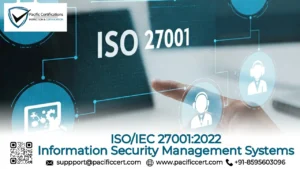What is ISO 22301?

ISO 22301:2019 is the international standard for business continuity management systems (BCMS). This standard sets the requirements for establishing, implementing, operating, monitoring, reviewing, maintaining and improving a documented management system to protect against disruptions, minimize the impact of unforeseen events and ensure recovery in case of an incident. ISO 22301 certification provides a structured approach to ensure organizations can continue operating or resume quickly after disruptions, such as natural disasters, cyber-attacks or other unforeseen crises.
The standard is designed to help businesses prepare for, respond to and recover from potential incidents that could impact operations. By following ISO 22301 certification, organizations can increase resilience, reduce risks and safeguard stakeholders, assets and reputation.
For more information, contact us at support@pacificcert.com.
Purpose
The purpose of ISO 22301:2019 certification is to provide organizations with a overreaching framework for creating a business continuity management system (BCMS) to ensure that essential functions can continue during and after a crisis. The standard helps organizations identify risks to business operations, develop recovery strategies and implement effective response plans. By meeting ISO 22301 standards, organizations demonstrate their commitment to maintaining operations and protecting stakeholders from the impact of disruptions.

Scope and Applicability
ISO 22301:2019 certification is applicable to any organization, regardless of size, sector, or location, that wants to establish and maintain a business continuity management system. The standard applies to organizations across industries such as healthcare, finance, manufacturing, telecommunications and any other sector where business continuity is critical for maintaining operations. It focuses on the development and maintenance of a BCMS to ensure that organizations can respond to and recover from incidents quickly, minimizing operational downtime and protecting assets, employees and customers.
ISO 22301:2019 certification is particularly valuable for organizations seeking to enhance their resilience, improve crisis management and comply with legal and regulatory requirements regarding business continuity.
Key Definitions
- Business Continuity: The ability of an organization to continue essential functions during and after a disruption.
- Business Continuity Management System (BCMS): A structured framework to manage risks, disruptions and recovery processes to ensure the continued operation of essential business functions.
- Incident: An event that disrupts normal business operations, such as a natural disaster, cyber-attack, or supply chain failure.
- Recovery: The process of restoring normal operations and functions following a disruption or incident.
- Risk Assessment: The process of identifying, analyzing and evaluating risks that could impact business continuity.
Clause-wise structure of ISO 22301:2019
Clause Number | Title | Description |
Clause 1 | Scope | Defines the scope of the standard and its applicability. |
Clause 2 | Normative References | Lists the referenced documents and standards. |
Clause 3 | Terms and Definitions | Provides key terms and definitions used in the standard. |
Clause 4 | Context of the Organization | Identifies the internal and external factors affecting the BCMS and its operation. |
Clause 5 | Leadership | Describes the role of leadership in establishing and maintaining the BCMS. |
Clause 6 | Planning | Defines the need for a risk assessment, business continuity objectives and continuity strategies. |
Clause 7 | Support | Specifies the necessary resources, training and communication for the BCMS. |
Clause 8 | Operation | Details the steps for implementing business continuity strategies and ensuring operational readiness. |
Clause 9 | Performance Evaluation | Focuses on monitoring, measuring and evaluating the performance of the BCMS. |
Clause 10 | Improvement | Emphasizes the need for continual improvement of the BCMS based on evaluation results and feedback. |
What are the ISO 22301 requirements?
ISO 22301 certification requires organizations to ensure business continuity by developing clear policies, assessing risks, creating recovery strategies and maintaining a continuous improvement cycle. By implementing these ISO 22301 requirements, organizations can better withstand disruptions and maintain operational resilience. The following are key ISO 22301 requirements for establishing a strong business continuity management system:

- Identify and evaluate risks to business operations and assess their potential impact to prioritize recovery efforts.
- Ensure top management is committed to implementing and maintaining the BCMS, with clear responsibility and accountability defined.
- Set measurable objectives to ensure the continuity of critical business functions during and after a disruption.
- : Develop business continuity strategies to address identified risks and ensure resources are available for effective response and recovery.
- Ensure that all relevant stakeholders are aware of the BCMS and their roles in it, with clear communication channels established.
- Regularly evaluate the BCMS to ensure its effectiveness and identify opportunities for improvement.
- Test business continuity strategies regularly and conduct drills to ensure readiness for a potential crisis.
For more information, contact us at support@pacificcert.com.
What are the ISO 22301 Certification benefits?
ISO 22301 certification enables organizations to ensure the continuity of operations during and after a disruption. By following the guidelines in this standard, organizations can enhance their resilience, reduce risks and demonstrate a proactive approach to crisis management. Below are the key ISO 22301 certification benefits:

- Certification helps organizations prepare for and recover from disruptions, reducing downtime and financial losses.
- Achieving certification helps organizations meet regulatory requirements and demonstrate compliance with industry standards.
- Certification boosts the organization’s reputation by showing customers, stakeholders and partners that business continuity is a priority.
- Certification assures customers, suppliers and other stakeholders that the organization is well-prepared to manage business disruptions.
As the frequency of disruptions increases due to factors such as natural disasters, cyber-attacks and supply chain vulnerabilities, the demand for ISO 22301 certification will continue to grow in the recent years. Organizations across industries will be increasingly required to demonstrate strong business continuity management practices to ensure resilience and protect their operations. This growing demand will further reinforce ISO 22301 as the global standard for managing business continuity risks.
ISO 22301 Certification Process
The ISO 22301:2019 certification process typically includes the following steps:
- Pre-Certification Assessment: Conducting a gap analysis to identify areas for improvement in business continuity processes.
- Documentation Review: Reviewing existing policies, procedures and documentation to ensure they meet ISO 22301 requirements.
- Stage 1 Audit: An initial review to assess the organization’s preparedness and identify any potential gaps in the BCMS.
- Stage 2 Audit: A thorough on-site audit to evaluate the implementation of business continuity strategies and testing protocols.
- Certification Decision: Certification is awarded once the organization meets all the requirements of ISO 22301 certification.
- Ongoing Monitoring: Regular surveillance audits ensure that the BCMS remains effective and compliant with ISO 22301 standards.
Timeline for ISO 22301 Certification
The timeline for ISO 22301 certification generally spans several months. The pre-assessment and preparation phase typically takes 1-2 months, during which the organization reviews its existing business continuity plans. The Stage 1 audit typically lasts about 1 month. The Stage 2 audit, which evaluates the implementation of business continuity processes, typically lasts 1-2 months. Certification issuance typically occurs within 3-6 months, depending on the audit findings and the organization’s readiness.
How much does ISO 22301 certification cost?
ISO 22301 certification cost depends on several factors, including the size and complexity of the organization, the number of employees and the scope of the business continuity plan. Typical costs include:
Audit fees is the fee for the certification body’s audit process. Training costs is the costs for educating staff on ISO 22301 and business continuity processes. Ongoing maintenance is the costs for regular audits, recertification and maintaining compliance every 3 years.
How Pacific Certifications Can Help?
At Pacific Certifications, we provide overreaching auditing and certification services for ISO 22301 certification. Our team will guide you through the entire certification process, ensuring that your organization complies with the highest standards for business continuity. Our services include:
- Stage 1 and Stage 2 audits to evaluate your business continuity processes.
- Objective conformity assessments based on ISO 22301.
- Certification issuance upon successful completion of the audit.
- Ongoing surveillance audits to ensure continued compliance.
- Support for multi-site or global operations.
For audits and certification, contact support@pacificcert.com.
ISO 22301 Training and Courses
Various training courses are available to help organizations comply with ISO 22301 training, including:
- Lead Auditor Training – Equips professionals to conduct external third-party audits.
- Lead Implementer Training – For those responsible for planning and executing ISO 22301 implementation.
- Internal Auditor Training – Preparing internal auditors for certification audits
Pacific Certifications provides accredited training programs. If your organization is looking for ISO 22301 training, our team is equipped to help you.
FAQs
How long does it take to get ISO 22301 certification?
The certification process typically takes 3–6 months, depending on your organization’s preparedness and audit outcomes.
Is ISO 22301 certification mandatory for all organizations?
While it is not legally required, ISO 22301 certification helps organizations improve their business continuity management processes, reduce risks and increase operational resilience.
What are the main benefits of ISO 22301 certification?
Certification improves business continuity, enhances customer confidence, ensures compliance with regulations and reduces the impact of disruptions on business operations.
Can I apply for ISO 22301 certification without a business continuity management system in place?
No, a business continuity management system must be in place before applying for certification to ensure compliance with ISO 22301.
How often do I need to renew ISO 22301 certification?
ISO 22301 certification is valid for three years, after which recertification is required.
Is ISO 22301 certification mandatory?
The certificate is voluntary. Some regulators or major clients may ask for it in contracts, yet ISO itself does not impose certification
What documents are mandatory when implementing ISO 22301?
A typical project requires a business-continuity policy, scope statement, risk assessment and business-impact analysis records, continuity strategy, incident response procedures, recovery plans and records of training and testing
Why is ISO 22301 important?
The standard underpins organisational resilience by identifying risks, preparing response measures and improving recovery time. It is widely viewed as the leading benchmark for continuity planning
Ready to get ISO 22301 certified?
Contact Pacific Certifications to begin your certification journey today!
Suggested Certifications –
Read more: Pacific Blogs






